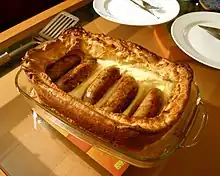Toad in the hole
Toad in the hole or sausage toad is a traditional English[1][2] dish consisting of sausages in Yorkshire pudding batter, usually served with onion gravy and vegetables.[3] Historically, the dish has also been prepared using other meats, such as rump steak and lamb's kidney.
 Toad in the hole, ready to be served | |
| Alternative names | Sausage toad |
|---|---|
| Place of origin | United Kingdom |
| Region or state | England |
| Serving temperature | Hot |
| Main ingredients | Sausages, Yorkshire pudding batter, onion gravy |
Origins
Batter puddings became popular in the early 18th century.[4] Cookery writer Jennifer Stead has drawn attention to a description of a recipe identical to toad in the hole from the middle of the century.[5]
Dishes like toad in the hole appeared in print as early as 1762, when it was described as a "vulgar" name for a "small piece of beef baked in a large pudding".[6] Toad in the hole was originally created as a way to stretch out meat in poor households.[7] Chefs therefore suggested using the cheapest meats in this dish. In 1747, for example, Hannah Glasse's The Art of Cookery listed a recipe for "pigeon in a hole", calling for pigeon rather than sausages.[8] In 1861 Isabella Beeton listed a similar recipe using rump steak and lamb's kidney, while Charles Elmé Francatelli's 1852 recipe mentions "6d. or 1s." worth of any kind of cheap meat.[9] This recipe was described as "English cooked-again stewed meat" (lesso rifatto all'inglese) or "toad in the Hole", in the first book of modern Italian cuisine,[10] which stressed that meat was to be left over from stews and re-cooked in batter.
Name
The dish with left over meat was originally not called toad in the hole. In the 1787 book A Provincial Glossary by Francis Grose, for example, "toad in a hole" was referred to as "meat boiled in a crust", though a 28 September 1765 passage in The Newcastle Chronicle reads, "No, you shall lay on the common side of the world; like a toad in a hole that is bak'd for the Devil's dinner". The first appearance of the word "hole" in the dish's name, not counting Pigeons in a Hole found in the cookbook by Hannah Glasse, appeared in the 1900 publication Notes & Queries, which described the dish as a "batter-pudding with a hole in the middle containing meat".[7] Despite popular belief, there is no record of the dish ever being made with toad.[7]
The origin of the name is unclear, but it may refer to the way toads wait for their prey in their burrows, with their heads poking out, just as sausages peep through the batter.[7][11] It may also derive from the "living entombed animal" phenomenon of live frogs or toads supposedly being found encased in stone, which was a popular hoax / false belief of the late 18th century.[12]
The term is sometimes used for "egg in the basket" (an egg fried in a hole of a slice of bread).[13]
References
- John Ayto (18 October 2012). The Diner's Dictionary: Word Origins of Food and Drink. OUP Oxford. pp. 372–. ISBN 978-0-19-964024-9.
- Bridget White (2013). Anglo-Indian Cuisine - A Legacy of Flavours from the Past. AuthorHouse. p. xi. ISBN 9781477251638. Retrieved 23 August 2018.
- Emily Ansara Baines (3 October 2014). The Unofficial Downton Abbey Cookbook: From Lady Mary's Crab Canapes to Daisy's Mousse Au Chocolat--More Than 150 Recipes from Upstairs and Downstairs. F+W Media, Inc. pp. 213–. ISBN 978-1-4405-8291-2.
- Alan Davidson (21 August 2014). The Oxford Companion to Food. OUP Oxford. pp. 822–. ISBN 978-0-19-104072-6.
- Jennifer Stead (1985). Georgian Cookery: Recipes & History. English Heritage. ISBN 978-1-85074-869-4.
- Mandelkern, India (11 October 2012). "The Secret History of Toad-in-a-Hole". Homo Gastronomicus. Retrieved 3 May 2020.
- Lavelle, Emma (20 June 2017). "How Toad-in-the-Hole Got Its Name". culture trip. Retrieved 27 September 2018.
- Hyslop, Leah (24 July 2013). "Potted histories: toad in the hole". Telegraph. Retrieved 9 September 2016.
- Francatelli, Charles Elme (1862). A Plain Cookery Book for the Working Classes. ISBN 0-946014-15-9.
- Pellegrino Artusi (1 February 2015). La scienza in cucina e l'arte di mangiar bene. E-text. ISBN 978-88-97313-74-8.
- Duncan McCorquodale (2009). A Visual History of Cookery. Black Dog. ISBN 978-1-906155-50-6.
- Jan Bondeson (1999). The Feejee Mermaid and Other Essays in Natural and Unnatural History. Cornell University Press. p. 297. ISBN 9780801436093. Retrieved 23 August 2018.
- Barrett, Grant (17 November 2012). "Names for an Egg in Toast Dish". A Way with Words, a fun radio show and podcast about language. Retrieved 20 February 2023.
External links
 Media related to Toad in the hole at Wikimedia Commons
Media related to Toad in the hole at Wikimedia Commons